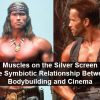- March 2024
- January 2024
- December 2023
- October 2023
- May 2023
- April 2023
- March 2023
- February 2023
- November 2022
- April 2022
- November 2021
- May 2020
- April 2020
- January 2020
- December 2019
- November 2019
- October 2019
- November 2018
- October 2018
- September 2018
- August 2018
- July 2018
- June 2018
- May 2018
- April 2018
- March 2018
- January 2018
- December 2017
- October 2017
Muscles on the Silver Screen: The Symbiotic Relationship Between Bodybuilding and Cinema

The pursuit of physical beauty is intimately associated with cinematic narrative. As we move further into modernity and media changes the way we consume things, bodybuilding has long since impacted not only screen visuals for the eye candy, but the stories they tell. In this essay we delve into bodybuilding and its cinema-muscle intertwined history—how muscularity has come to represent not just power but transfiguration, too.
The Rise of Silver screen Muscleheads
Bodybuilding’s relationship with film dates to the heyday of Hollywood. Mid-twentieth century cinema was blessed with the presence of actors such as Charles Atlas, and Steve Reeves (who were also bodybuilders). However, Reeves, especially, gained fame thanks to his role as Hercules in 1958’s “Hercules” where a generation came to admire his muscular frame making him an icon of fitness as he helped popularize bod-building worldwide.
Arnold Schwarzenegger: The Ultimate Crossover
One name stands out in the realm of bodybuilding and cinema like no other – Arnold Schwarzenegger. The Austrian Oak not only dominated the bodybuilding world with his seven Mr. Olympia titles but also conquered Hollywood with his charisma and imposing presence. From bodybuilder to film action-star roles of Conan the Barbarian and The Terminator, revealed another pathway, for a new way to go beyond the muscular limits into mainstream acting.
It wasn’t just all showmanship — as Arnold proved you had to have discipline and motivation to achieve such perfectionism physically as well. Transformation was a big thing for bodybuilders, it is a common idea with many films surrounding it.
Transformation and Redemption
Bodybuilding has been used as a narrative device in cinema to convey transformation and redemption. Films like “Rocky” and “The Wrestler” focus on characters who use physical training, including bodybuilding, to reclaim their lives and find redemption. The physical transformation parallels their emotional journey, making the muscle-building process a powerful symbol of personal growth.
Muscles as Symbols of Power
In cinema, muscles have often been associated with power and dominance. Superhero films like “The Avengers” series and “Black Panther” showcase actors who undergo rigorous training to embody their characters’ superhuman strength. These actors, with their imposing physiques, not only become literal embodiments of power but also serve as aspirational figures for audiences.
Vulnerability Beneath the Muscle
While muscles often symbolize power, they can also be used to reveal vulnerability beneath the tough exterior. Another pro wrestler-turned-actor, Dwayne “The Rock” Johnson, has flexed his muscles for portrayals of characters that grapple with power, pain, and vulnerability. In “Pain & Gain” and “Jungle Cruise,” the roles he plays show an extensive repertoire of emotions breaking through those Classic Molds of pumped-up men.
Female Bodybuilders in Cinema
It’s not just male bodybuilders who have left their mark on cinema. Female bodybuilders like Rachel McLish and Cory Everson have also made appearances in films, challenging conventional beauty standards, and providing representation for women in the world of bodybuilding. Their inclusion in movies like “Pumping Iron II: The Women” has helped break down barriers and broaden the scope of body image in cinema.
Conclusion
Bodybuilding and cinema share a rich and intertwined history. From the early pioneers of the silver screen muscles to the modern-day action heroes and heroines, the relationship between these two worlds continues to evolve. Muscles have become a symbol not just of physical prowess but also of transformation, power, vulnerability, and even social change. As cinema continues to explore new narratives and perspectives, the influence of bodybuilding on the big screen is likely to remain a vital and enduring element of cinematic storytelling.
REFRENCES
Maximize Muscle Gains : Dive into Performance Enhanced Supplements
From Vitamin A to Zinc : Exploring the Impact of Essential Supplements
The Muscle Builders Toolbox : Essential Vitamins and Minerals for Muscle Growth
Six-Pack Abs Exercise and Use of Supplements for Toned Body

Leave a Reply